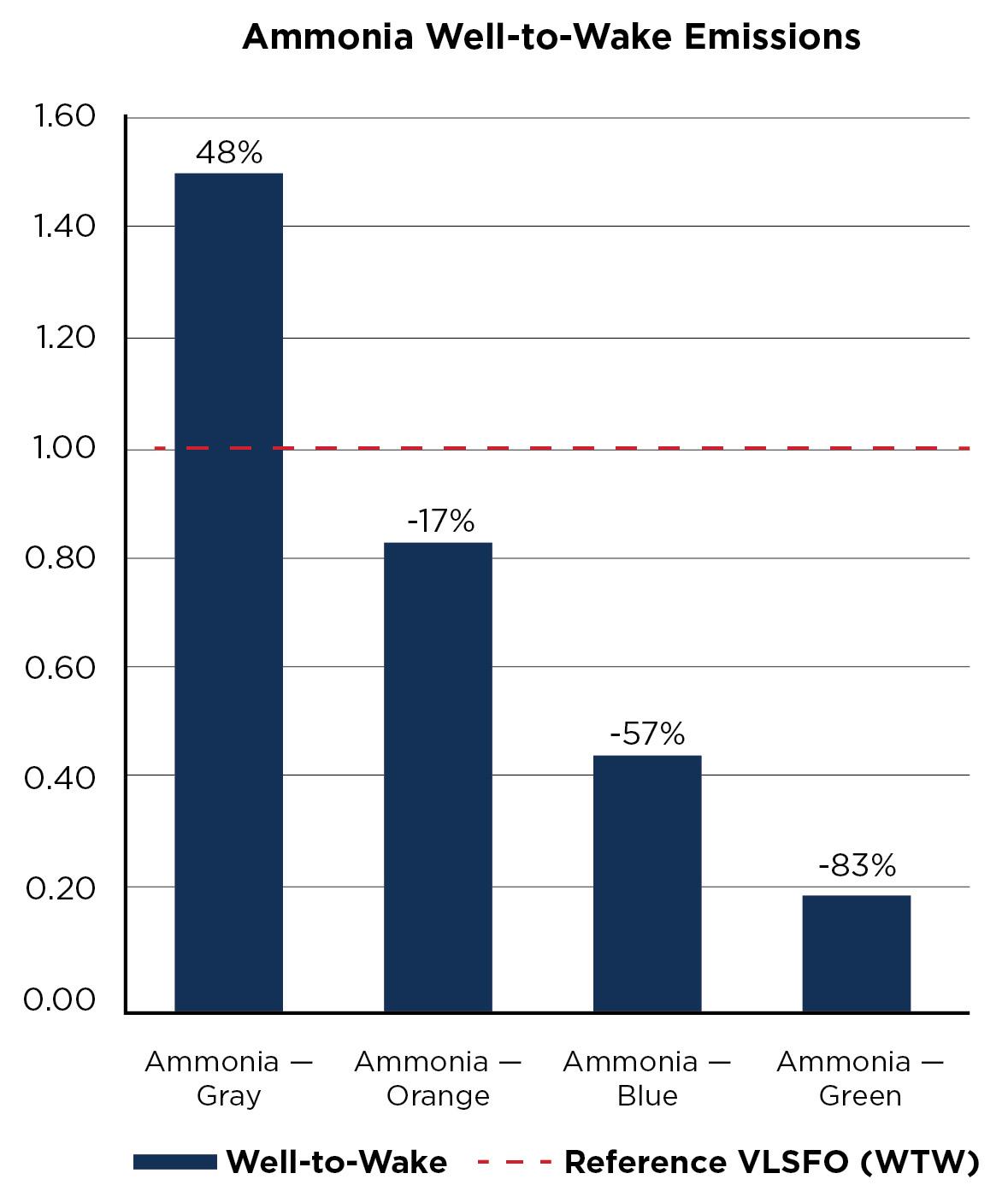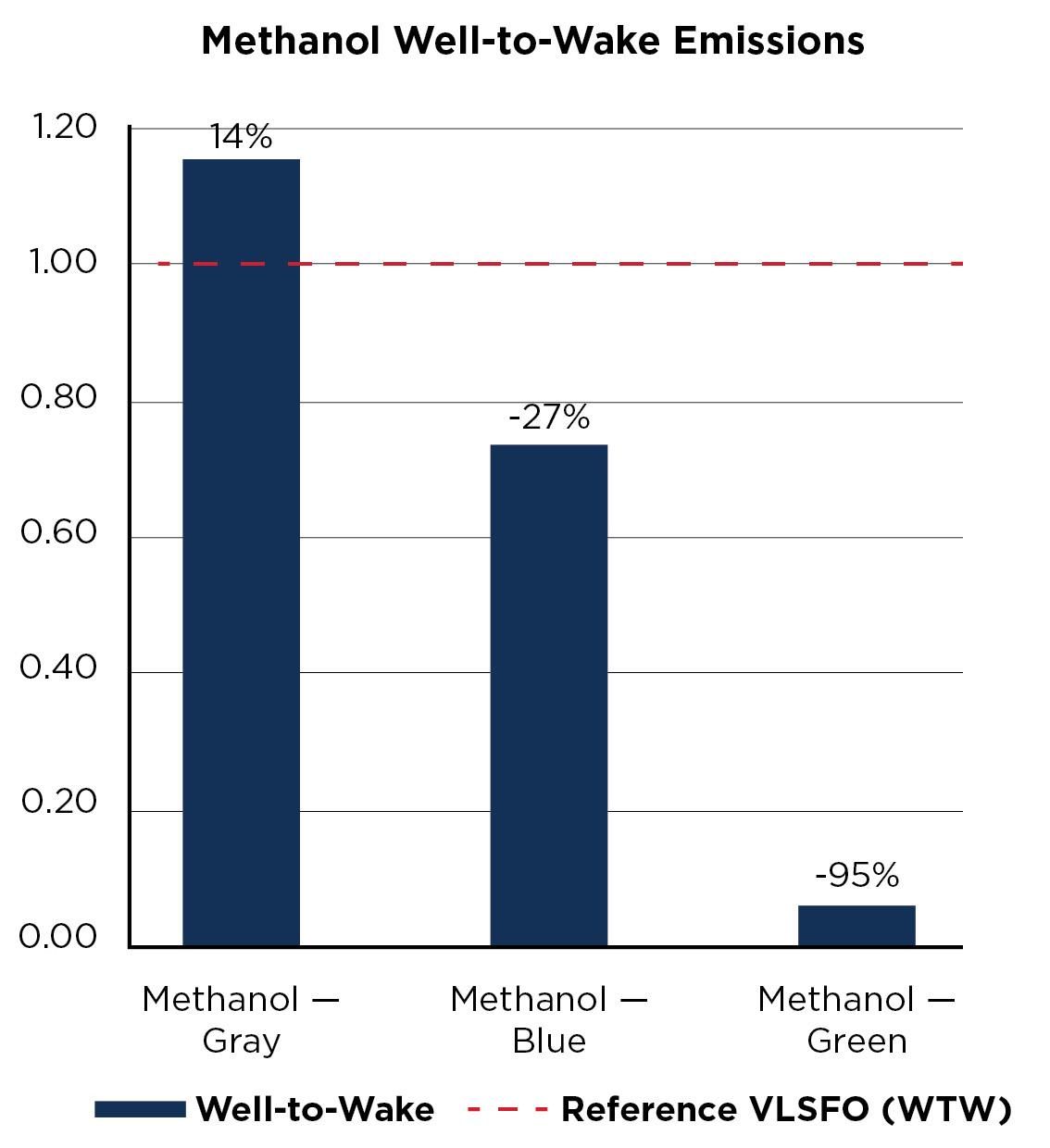
4 minute read
Life-cycle Analysis of the Heavy Gas and Alcohol Pathway Fuel Options
Alternative fuels will play a dominant role in the decarbonization of the marine and offshore sectors and are expected to yield the most benefits for reducing greenhouse gas (GHG) emissions. The current regulatory framework is focused on vessel emissions (tank-to-wake) rather than the overall life-cycle emissions of a given fuel (well-to-wake). However, it is recognized throughout the industry that the life-cycle carbon footprint of fuels provides the most complete description of their environmental impact.
This section presents comparative analyses of some of the alternative marine fuels and their life-cycle emissions, with the objective of offering a holistic view of the challenges associated with adopting low- and zero-carbon fuels.
AMMONIA

Figure 7: Normalized well-to-wake CO₂ emissions comparison for ammonia.
Ammonia can be produced either by fossil sources such as natural gas or renewably from hydrogen through electrolysis of water. Production from fossil sources is highly energy intensive and thus results in a high carbon footprint, which conceptually defeats the purpose of using a zero-carbon fuel. However, its production from water using renewable energy has the potential to practically eliminate carbon emissions for ammonia on a life-cycle basis.
Figure 7 shows a comparison of normalized well-to-wake emissions for gray, orange and green ammonia normalized against the well-to-wake emissions of VLSFO. Production of gray ammonia is estimated to have 48 percent higher life-cycle carbon emissions than VLSFO. For orange ammonia, assumed to be a 50/50 percent blend of gray and green, the life-cycle carbon emissions are 17 percent lower than those of VLSFO. Blue ammonia has life-cycle carbon emissions 57 percent lower than VLSFO. Finally, green ammonia is estimated to have 83 percent lower life-cycle carbon emissions than VLSFO.
Any tank-to-wake emissions for ammonia result from the need to use pilot fuel for combustion and any formation of N₂O, which is a potent GHG. The contribution of pilot fuel accounts for 3.5 percent of the well-to-wake emissions of gray ammonia, while the N₂O is estimated to account for 10 percent. The latter is based on assuming the same amount of N₂O emitted as the methane slip in an Otto-cycle engine for simplicity.
The current regulatory framework accounts for only the tank-to-wake emissions, thus the use of gray ammonia would enable an important reduction of the carbon intensity of marine vessels. However, from a life-cycle perspective, it is important to develop technologies that support the production of green ammonia at a larger scale, as it is a promising pathway towards carbon neutrality.
Currently, the price of gray ammonia is estimated to be $230/ton. Using the same assumptions as for green LNG, the price of green ammonia would be $670/ton, or about three times more expensive than gray ammonia. If a blend of 50 percent gray and 50 percent green (orange) is used, the price can be reduced to $460/ton, making ammonia cost competitive against VLSFO, which is offered currently at an average of $450/ton at ports around the world. The orange ammonia blend can also reduce the life-cycle carbon emissions by 28 percent compared to VLSFO, which makes it an attractive option from environmental and economic perspectives.
Recent developments support the adoption of ammonia as a viable marine fuel. In the U.S., Monolith Materials announced a plant to produce up to 275,000 tons of ammonia by using methane pyrolysis powered by green renewable energy. Ørsted and Yara also announced plans to produce 75,000 tons of green ammonia per year using Ørsted’s offshore renewable energy production. Additionally, Saudi Aramco announced in 2020 the first shipment of blue ammonia which is produced by re-injecting CO₂ emissions generated during the production process into the wells for enhanced oil recovery.
METHANOL
Methanol can be produced from hydrogen and CO₂ via the methanol synthesis process. This capability enables the production of green methanol where the hydrogen is sourced from electrolysis of water and the CO₂ is captured from the atmosphere using CCS systems. Therefore, on a life-cycle basis, green methanol has the potential to remove CO₂ from the atmosphere and thus offset part of the emissions generated from its combustion onboard.
The quantity of CO₂ that can be captured and used for methanol production can vary. A pilot plant in Germany produced one ton of methanol using 1.5 tons of CO₂. Other sources provide estimates of over three tons of CO₂ captured per ton of produced methanol. For simplicity, the first one is used to derive the blue methanol values, where the 1.5 tons of CO₂ equivalent are removed from the well-to-tank portion of the gray fuel. For green methanol, which can almost achieve carbon neutrality, as shown in Figure 9, it was assumed that the only emissions remaining are emissions from the combustion of pilot fuel. Blue methanol can still enable a 27 percent reduction in well-to-wake carbon emissions compared to VLSFO.

Figure 9: Normalized well-to-wake CO₂ emissions comparisons for methanol.
However, carbon neutrality for methanol is highly dependent on the deployment of technologies that capture a sufficient amount of carbon during its production.
Based on the current market prices, gray methanol is estimated at $460/ton at the Port of Rotterdam. Using the same assumptions as for green LNG, the price of green methanol can be estimated at $709/ton, or less than twice the cost of gray methanol. If a blend of 50 percent gray and 50 percent green is used, the price can be reduced to $585/ton, which brings the price of orange methanol to a competitive level against VLSFO while reducing life-cycle carbon emissions.




